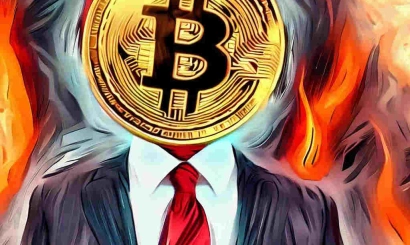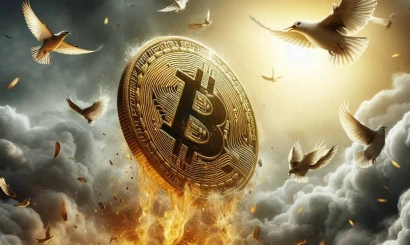One of the best months. What will happen to Bitcoin in February
Experts explained what to expect from Bitcoin's exchange rate in February
Experts analyzed the market situation and shared insights into the behavior of the leading cryptocurrency in the coming month.
On Monday, February 5, Bitcoin (BTC) is trading around $43,000. Despite significant volatility in the past month, its price has returned to the level of the first days of 2024. Sharp price fluctuations of the cryptocurrency were observed against the backdrop of the entry of a group of spot exchange-traded funds (ETFs) into the U.S. market.
BTC/USD
42,715 -188 (-0.44%)
Experts analyzed the current state of the crypto market, summarized January, and shared insights into how the leading cryptocurrency will behave in February.
"A clearly defined price range"
Cryptocurrency market analyst Victor Pershikov
"As a result of January, Bitcoin has formed a clearly defined price range, limited by levels of $40,000 and $49,000, within which, in my opinion, the price may remain at the end of the next month. The market's calm acceptance of the approval of spot ETFs in the U.S., as well as the lack of fuel for further growth at the moment, does not provide opportunities for a benchmark price increase.
Following the January meeting of the U.S. Federal Reserve (Fed), market participants received a clear signal that while the probability of easing monetary policy (DMP) exists, it is pushed back in time towards the end of the first half of the year, and significantly depends on macroeconomic data that will be released in the next couple of months. Thus, until the actual situation in the U.S. economy in terms of inflation and employment is clarified, there is no need to expect an easing of DMP and an increase in risky assets.
I assume that Bitcoin may attempt to break out of the current range in February, for example, breaking the lower boundary at $40,000, but I do not expect a significant movement this month. The upcoming halving provides certain support to the exchange rate, and there are no significant negative factors capable of leading the benchmark to collapse at the moment."
"Consider all factors"
Co-founder of ENCRY Foundation Roman Nekrasov
"To understand what February holds for the most capitalized cryptocurrency, it is necessary to consider all the factors of possible pressure on its price.
The Fed's decision on the key interest rate is already known - the regulator left it unchanged at the end of January and hinted at a reluctance to lower it even as the March meeting approaches. The crypto market reacted to the news with a slight correction but soon regained its position. Such behavior suggests that the Fed's decision was not unexpected for investors. However, hints of unwillingness to lower the rate - a negative factor, as changes could have increased the investment attractiveness of such high-risk assets as cryptocurrency.
On the other hand, we see a decrease in the outflow of assets from the Grayscale Bitcoin Trust (GBTC). Changes indicate that the process of fixing profits by investors is coming to an end, reducing pressure on BTC. It can be assumed that it is in February that the market will finally see the expected positive effect from the launch of spot Bitcoin ETF trading. In January, investors did not see a sharp rise largely due to GBTC investors fixing profits. Now the influence of this factor is disappearing.
Now let's consider February from the point of view of the theory of cyclicity. There are just over 70 days left until the Bitcoin halving. Observations show that BTC can demonstrate positive dynamics in the period before such an event. True, in 2020, the execution of the scenario was prevented by the "black swan" that arose against the backdrop of the COVID-19 pandemic. This year, Bitcoin is likely not to face such obstacles.
Expectations of a positive effect from the launch of spot Bitcoin ETF trading in the U.S., plus positive expectations from the halving, can give Bitcoin enough strength to grow already in February. Observations show that February is one of the best months for Bitcoin. Over 13 years, the cryptocurrency has only three times demonstrated negative dynamics in the last month of winter.
An increase in trading volumes in the market for spot Bitcoin ETFs can also support the transition of the cryptocurrency to growth, as issuers of instruments continue to buy up free coins from the market. There are all reasons to believe that in February, Bitcoin will be able to return to local highs near $49,000."
"February does not herald radical changes"
Commercial Director of the OKX exchange Lennix Lai
"So far, February does not herald radical changes in the cryptocurrency market. The effect of approving the launch of a Bitcoin ETF has already been taken into account by the market and fully played out, and the effect of the upcoming Bitcoin network halving has not yet come into its full force.
Bitcoin will be supported by investors' hopes for a reduction in the key rate in the U.S., a gradual influx of institutional capital into cryptocurrencies through ETFs, as well as geopolitical tension, which has already contributed to the rise in gold prices. However, the absence of clear and powerful stimuli will impede the growth of Bitcoin.
Moreover, investors are concerned about the possible start of payments to creditors of the Mt.Gox exchange. Users who receive payments may prefer to sell the long-awaited coins, which will lead to a sharp increase in supply in the market, putting pressure on the price of Bitcoin. However, there are still no exact dates for the start of compensation payments. In the grip of these factors, the cryptocurrency will either grow or decline, reacting largely to situational macroeconomic indicators.
In February, one can expect a multi-directional movement of Bitcoin throughout the month with a moderate range of fluctuations in the range of $35,000–37,000 to $45,000–47,000."
- Hopeless Deception: FTX Owners Abandon Plans to Revive the Exchange
- Bitcoin closed in the positive for the fifth consecutive month, marking the first time since the pandemic began.
- Bitcoins from Silk Road. Whose coins the US government is selling at auction.
- "Need new drivers." What will happen to Bitcoin in the coming week?
- Deutsche Bank Survey: Investors Brace for Bitcoin to Plummet Below $20,000
- Experts explain the reasons for the decline in the Bitcoin exchange rate






